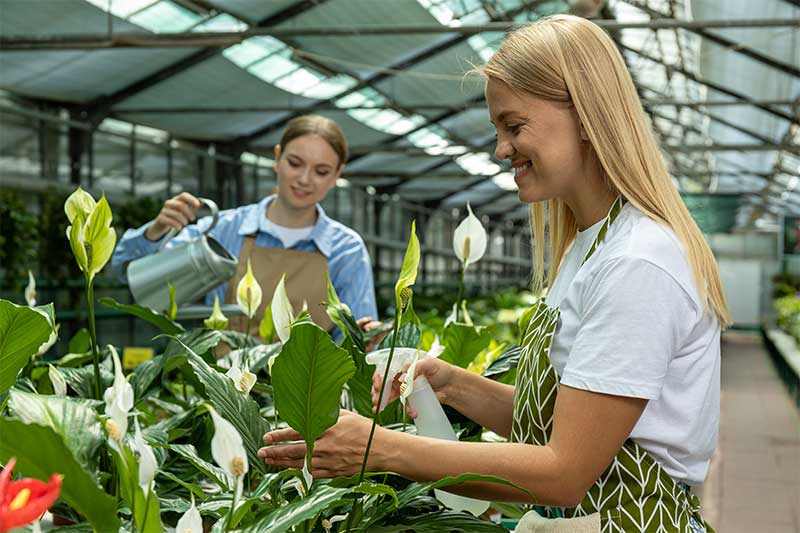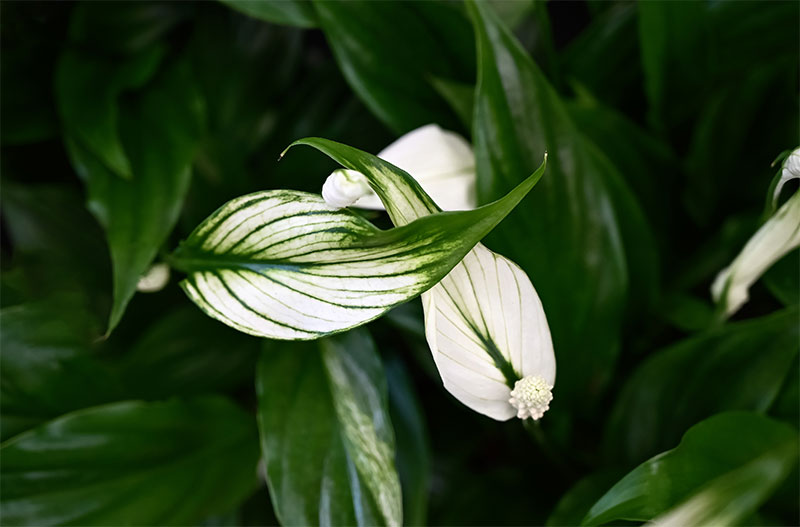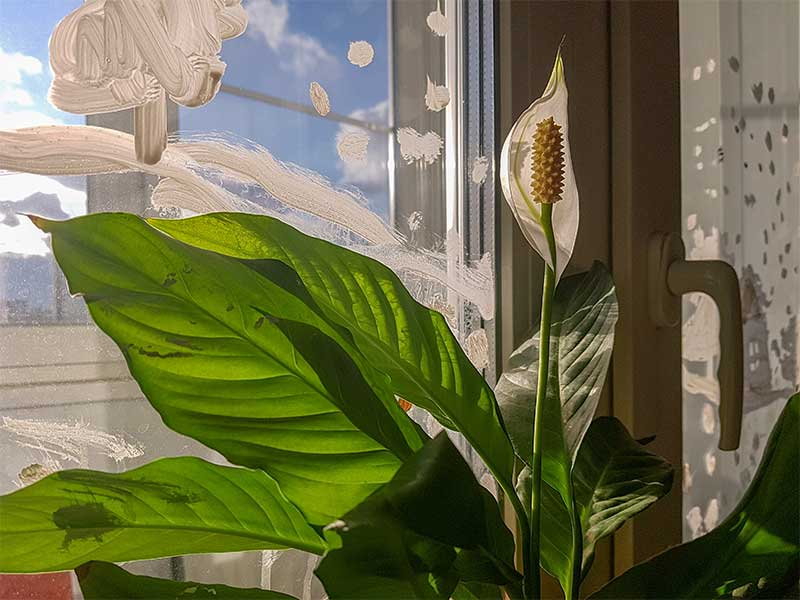Variegated peace lilies, with their striking patterns and lush foliage, have become a staple in indoor gardens and spaces seeking a touch of nature's elegance. This comprehensive guide dives deep into the care, propagation, and aesthetic value of these enchanting plants, ensuring both novice and experienced gardeners can cultivate thriving variegated peace lilies.
Introduction to Variegated Peace Lily
Understanding “Variegation”
Variegation refers to the appearance of differently colored zones in the leaves and sometimes the stems of plants. In variegated peace lilies, this results in stunning patterns of green and white or yellow, making each leaf a unique piece of natural art.
The Origins and Popularity of Variegated Peace Lilies
Variegated peace lilies, particularly the Spathiphyllum 'Domino,' are prized for their beauty and adaptability. Originating in tropical Americas, their popularity has soared due to their air-purifying qualities and visually striking variegated foliage.
Daily Care for Variegated Peace Lily
Light: Finding the Perfect Balance
Achieving the perfect balance of light for variegated peace lilies is essential to their health, growth, and the vibrancy of their unique leaf patterns. These plants are notable for their striking variegated foliage, which requires a specific amount of light to maintain its distinctive appearance.
Variegated peace lilies thrive in bright, indirect light, a condition that closely mimics the natural, dappled sunlight of their native tropical rainforest understory. This level of light is crucial for encouraging the full expression of the plant's variegation without causing harm. Direct sunlight, on the other hand, can be detrimental, leading to scorched and damaged leaves, while insufficient light may result in reduced variegation, affecting the plant's aesthetic appeal.
Ideal placement for these plants includes locations near east-facing windows, which offer gentle morning light, or north-facing windows that provide consistent but soft light throughout the day. For those with south or west-facing windows, employing sheer curtains or positioning the plant a few feet away from direct light can mitigate the intensity of the sun, protecting the leaves from potential burn.
In situations where natural light is inadequate, artificial lighting, such as LED or fluorescent grow lights, can serve as an effective substitute, ensuring the plant receives the necessary spectrum of light for approximately 12-14 hours daily to simulate natural conditions.
It's a common misconception that more light always equates to better growth for variegated peace lilies. However, too much direct sunlight can actually harm these plants, causing the leaves to become brown and crispy at the edges. Regularly rotating the plant can help ensure even light exposure, promoting balanced growth and preventing the plant from leaning towards the light source. Monitoring the plant's reaction to its lighting environment is key; symptoms of excessive light include faded or scorched leaves, whereas signs of insufficient light involve leggy growth and diminished variegation. Adjustments may be necessary to find the optimal lighting balance, especially as the intensity of sunlight changes with the seasons. In summer, it's important to shield the plant from the stronger sunlight, while in winter, efforts should be made to maximize light exposure to compensate for shorter days and weaker light intensity.
Soil: The Foundation of Growth
Selecting the right soil mix for variegated peace lilies is crucial for their health and growth. An ideal mix combines peat, perlite, and vermiculite in equal parts to ensure a perfect balance between moisture retention and adequate drainage. Peat moss helps in retaining moisture, while perlite enhances soil aeration and drainage, preventing water from accumulating at the roots. Vermiculite contributes by holding onto nutrients and releasing them slowly to the plant roots, supporting consistent growth without the risk of nutrient burn.
This tailored soil mix not only maintains the moisture levels ideal for peace lilies but also promotes a healthy root system through its loose structure, ensuring ample aeration and a steady nutrient supply. By mimicking the plant's natural habitat, this mix allows variegated peace lilies to thrive indoors, displaying their lush foliage and vibrant variegation. Gardeners should aim to keep the soil within a slightly acidic to neutral pH range, adjusting the mix as necessary to meet these conditions, thereby ensuring the plant's vitality and beauty.
Water: The Elixir of Life
The watering regime for variegated peace lilies is a delicate balance that significantly influences their health and appearance. These plants demand consistent moisture, but their watering needs fluctuate based on environmental factors such as light exposure and ambient temperature. A practical approach is to wait until the top inch of the soil has dried out before applying water again. This method helps mimic the natural moisture cycle the plants would experience in their native habitat, promoting healthy root development and preventing water stress.
However, the signs of over-watering or under-watering are unmistakable and detrimental. Over-watering can suffocate roots, leading to yellow leaves, while under-watering causes the plant to conserve resources, resulting in brown leaf tips. These symptoms are the plant's distress signals, indicating that adjustments in watering frequency or quantity are necessary. Achieving the right watering balance is crucial for maintaining the plant's vibrant foliage and overall health.
Temperature and Humidity: Creating the Ideal Environment
Creating the ideal temperature and humidity environment is pivotal for the health and well-being of variegated peace lilies. These tropical plants thrive in a temperature range of 65°F to 80°F (18°C to 27°C), which closely mirrors their native habitat's climate. Temperatures outside this range, particularly cold drafts or extreme heat, can stress the plants, leading to poor growth or even damage. To maintain consistent temperatures, position your peace lilies away from drafty windows and doors in the winter, as well as direct air conditioning flows in the summer.
Humidity plays an equally crucial role in the care of variegated peace lilies. They flourish in high humidity environments, which support their lush foliage and vibrant variegation. Indoor air, especially in homes with central heating or air conditioning, can become too dry for these moisture-loving plants. To increase humidity, you can regularly mist the plants, use a pebble tray filled with water placed under the plant's container (ensuring the pot does not sit directly in water), or employ a humidifier in the room. These methods help mimic the humid conditions of their natural habitat, promoting healthy growth and preventing issues such as brown leaf tips, which often indicate low humidity levels.
Fertilizer: Fueling Growth
Fertilizing variegated peace lilies is a critical aspect of their care, acting as the fuel that supports their lush, vibrant growth. A balanced, water-soluble fertilizer, ideally with an equal ratio of nitrogen, phosphorus, and potassium (e.g., 20-20-20), should be applied every 6 to 8 weeks during the active growing season, typically from spring through early fall. Diluting the fertilizer to half the recommended strength is essential to prevent fertilizer burn, which can manifest as brown tips on the leaves or a white, crusty buildup on the soil surface. This approach ensures that the plants receive the necessary nutrients without the risk of chemical damage, promoting healthy foliage and robust growth.
Propagating Variegated Peace Lily
When it comes to propagating variegated peace lilies, the method chosen can significantly impact the success and appearance of the offspring plants. Dividing the root ball is the most effective method for ensuring that the new plants retain the desirable variegation patterns seen in the parent. This technique involves gently separating the plant's roots into smaller sections, each with an adequate amount of foliage and root mass, and potting them in separate containers. Seeding, while possible, is less commonly used for variegated varieties as the variegation may not reliably pass to the seedlings. Division not only helps maintain the aesthetic qualities of the variegation but also rejuvenates older plants by giving them more space to grow.
Potting and Repotting Variegated Peace Lily
Identifying the Time for Repotting
Identifying the right time to repot variegated peace lilies is crucial for their continued health and growth. Key indicators that signal the need for repotting include roots visibly growing out of the drainage holes and a noticeable slowdown in growth, suggesting the plant has outgrown its current container. Additionally, if the soil dries out more quickly than usual or the plant becomes top-heavy and prone to tipping over, these are clear signs that it's time to provide your peace lily with a new home.
Step-by-Step Guide to Repotting
A step-by-step guide to repotting ensures a smooth transition for the plant and promotes its healthy development in its new pot.
Begin by choosing a new pot that is 1-2 inches larger in diameter than the current one to allow sufficient room for growth without overwhelming the plant with too much space. Ensure the pot has adequate drainage holes to prevent water accumulation.
Gently remove the peace lily from its current pot, taking care to support the base of the plant and the soil around the roots. Use your fingers or a soft brush to loosen any tightly bound roots, encouraging them to spread out in their new environment.
Place a layer of fresh, well-draining potting soil in the bottom of the new pot, then position the plant so that its crown (where the stems emerge from the soil) sits at the same level as in the previous pot, ensuring not to bury the crown of the plant.
Fill in around the plant with more potting mix, gently firming it to eliminate air pockets, and water thoroughly to settle the plant and soil.
This careful approach to repotting not only revitalizes variegated peace lilies by providing fresh nutrients and space to grow but also minimizes stress, allowing them to thrive in their new setting.Carefully remove the plant, detangle roots, and place it in a slightly larger pot with fresh soil, ensuring not to bury the crown of the plant.
Common Problems with Variegated Peace Lily
Variegated peace lilies can encounter a few common issues, such as yellowing and wilting leaves or brown leaf tips, each indicative of specific care missteps. Understanding and addressing the underlying causes of these problems can significantly improve the health and appearance of your plant.
Solutions for Yellowing and Wilting Leaves
Yellowing and wilting leaves often stem from improper watering practices. Over-watering is a frequent issue, leading to root rot and subsequent yellowing and drooping of leaves as the plant's root system is damaged and unable to properly uptake water and nutrients. Conversely, under-watering can also cause wilting as the plant struggles to maintain hydration. To prevent these issues, ensure the plant is watered only when the top inch of soil feels dry to the touch, allowing for a cycle of drying and watering that mimics the natural moisture fluctuations of the peace lily's tropical habitat. Additionally, providing bright, indirect light supports healthier water usage and photosynthesis, further preventing yellowing leaves.
Causes and Prevention for Brown Leaf Tips
Brown leaf tips on variegated peace lilies can signal several problems, including low humidity, over-fertilization, or the presence of fluoride or other chemicals in tap water. These plants thrive in higher humidity environments; thus, increasing humidity through misting, using a pebble tray, or employing a humidifier can alleviate dry tip issues. Over-fertilization should be avoided by diluting fertilizers to half strength and applying them only during the growing season. Finally, if your tap water is high in fluoride or chlorine, switching to distilled or rainwater can prevent the brown tipping associated with these chemicals. By addressing these specific care aspects, gardeners can significantly reduce common problems and enjoy the lush, vibrant beauty of their variegated peace lilies.
Conclusion
Variegated peace lilies offer a unique blend of beauty and functionality, serving as living decor while enhancing indoor air quality. With the right care, they can be a captivating addition to any plant collection or interior space, demonstrating the enduring appeal of these variegated wonders.





